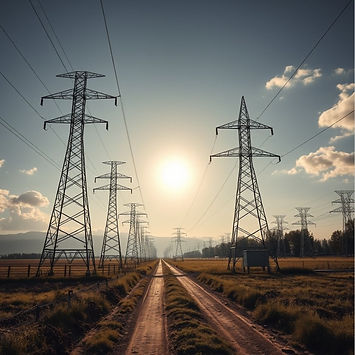Understanding Non-Commodity Costs
Your electricity bill comprises various components, not just the cost of wholesale energy. A significant portion of your electricity cost (kWh Unit Rate) consists of non-commodity charges that are unrelated to the direct purchase of wholesale energy. At E3 Energy, we specialise in non-commodity charges and are committed to providing expert guidance and support. If you require assistance in understanding these charges and how they are applied within supplier agreements, our specialist team is here to help. To assist you further, we have compiled the article below to help you understand each element, their role, and the importance they play in the distribution and transportation of electricity.


Understanding Non-Commodity Costs
In the realm of UK electricity costs, non-energy components go beyond actual generation, playing a pivotal role in strengthening the resilience of the power system. Transmission and distribution costs form the financial backbone of the grid infrastructure, ensuring the smooth delivery of electricity to end consumers. Simultaneously, system operator charges support the real-time balance between supply and demand, a critical factor for grid stability.
Non-energy components also encompass balancing services charges, which address the instantaneous adjustments needed to cope with demand fluctuations. The purpose of the capacity market charge is to incentivise investments in cost-effective, sustainable, and low-carbon electricity.
Furthermore, renewable obligation and feed-in tariff costs are fundamental in promoting sustainable energy practices, aligning with broader environmental objectives. Embedded within non-energy components are environmental and social levies that actively contribute to supporting eco-friendly initiatives. Additionally, taxes and levies generate revenue earmarked for public services and overarching policy goals. Together, these components establish a comprehensive and diverse cost structure essential for securing a reliable, sustainable, and socially responsible electricity landscape.
Non-commodity costs now represent an increasing share of the total electricity price, which on average can be 60% of the electricity unit rate you pay as a consumer. The guide below provides insight into the components of these charges and how they are likely to evolve in the future.
Types of Non-Commodity Charges
Network and Security of Supply Charges
These charges cover the costs of delivering electricity from the generation source to the end user via the networks.
Key components include:
-
Transmission Use of System (TNUoS) and Distribution Use of System (DUoS): Costs for using the transmission and distribution networks.
-
Balancing Services Use of System (BSUoS): Charges for maintaining network stability and balancing supply and demand.
-
Capacity Market (CM): Costs to ensure sufficient supply during periods of peak demand.
Environmental Charges
These are the non-commodity charges associated with government environmental policies aimed at incentivising investment in low-carbon and renewable energy generation. Environmental charges have been instrumental in the decarbonisation of the UK electricity sector, supporting the transition to cleaner energy sources. However, they also represent the largest contributor to recent increases in electricity prices. Understanding these charges is essential for navigating the increasingly complex landscape of energy pricing and anticipating how these elements may develop in the future.
Non-Energy Components Breakdown
1. Assistance for Areas with High Electricity Costs (AAHEDC)
Commonly referred to as the Hydro Benefit, the AAHEDC is a socialised levy designed to subsidise the high electricity distribution costs in Northern Scotland. This charge is applied to all electricity supplied from the transmission system to users across Great Britain. It remains relatively small and stable. The National Grid publishes a draft tariff in March, with the final charge confirmed in July.
2. Balancing Services Use of System (BSUoS)
Balancing Services Use of System (BSUoS) charges are used by National Grid to recover the costs of balancing the electricity transmission system. These charges ensure the network operates efficiently and maintains a steady electricity supply.
Up until April 2023, BSUoS costs were recovered through a £/MWh rate, calculated retrospectively for each balancing period based on the actual costs incurred and the total demand and generation volumes. These rates were published after the balancing period, once volumes and costs were finalised.
From April 2023, National Grid has transitioned to a fixed six-monthly £/MWh rate, calculated based on estimated demand volumes only. Generation volumes are now exempt. This change eliminates the need for half-hourly retrospective pricing, providing consumers with greater price certainty by publishing rates in advance.
3. Contracts for Difference (CfD)
The Contracts for Difference (CfD) scheme is the most recent subsidy initiative aimed at encouraging investment in low-carbon electricity generation. It is currently the only subsidy available for large-scale generation projects. Under the CfD scheme, generators participate in a competitive auction to secure a pre-agreed "strike price" for each megawatt-hour (MWh) of electricity produced. This guarantees a stable return on investment and shields generators from fluctuations in the wholesale power market.
When wholesale prices fall below the strike price, the CfD scheme provides a top-up payment to the generator to ensure the agreed strike price is met. Conversely, when wholesale prices exceed the strike price, the generator returns the difference back to the scheme.
The CfD mechanism provides financial stability for generators while protecting consumers from excessive costs during periods of high wholesale prices.
4. Climate Change Levy (CCL)
The Climate Change Levy (CCL) is a government tax on the use of both gas and electricity for businesses, agriculture and the public sector. This will appear as a separate charge on your invoice and is subject to the standard rate of VAT.
5. Capacity Market (CM Obligation)
The Capacity Market (CM) scheme ensures a secure electricity supply during periods of system stress. Generators and demand-side resources participate in competitive auctions to secure a price for providing capacity when needed. Demand-side response contributes by offering capacity through reduced demand. This scheme provides a predictable revenue stream to cover Capacity Market auction and administration costs. Costs are calculated based on estimated demand during the peak CM period: weekdays between 16:00 and 19:00 from November to February.
Capacity Market Peak: The CM peak period focuses on times of high demand to ensure sufficient capacity is available to maintain grid reliability. The scheme plays a vital role in safeguarding the electricity supply during critical periods.
6. Distribution Use of System (DUoS)
Distribution Use of System (DUoS) charges are levied by Distribution Network Operators (DNOs) to recover the costs of operating, maintaining, and upgrading the regional electricity distribution networks. These networks transport electricity from the transmission grid to end users. Given the complexity of the distribution network and the diversity of end users (e.g., variations in voltages and meter types), each region has multiple DUoS tariffs.
Tariff Structure
DUoS charges are applied based on:
-
Unit Rates: Charges per unit of electricity consumed.
-
Standing Charges: Fixed daily or monthly charges.
These charges are settled either: Half-Hourly (HH): For customers with advanced metering systems that record consumption every 30 minutes.Non-Half-Hourly (NHH): For customers without advanced meters, where consumption is estimated.
DUoS charges vary by region and are tailored to reflect the specific costs of the local network.
7. Energy Intensive Industries (EII) Support Levy (ESL)
The Government has introduced several measures to improve the competitiveness of Energy Intensive Industries (EIIs). These include:
Green Levy Exemption: Increasing the exemption for EIIs from 85% to 100%, effective April 2024. This results in a 0.015p/kWh increase for non-EII customers.
Capacity Market Cost Exemption: Extending the exemption to cover Capacity Market costs from October 2024. This leads to a 0.02p/kWh increase for non-EII customers.
Network Charging Compensation Scheme: Introducing compensation for grid-related network charges starting April 2025, with a 0.15p/kWh increase for non-EII customers.
8. ELEXON - Electricity Market Reform Settlement Operator
This fee covers the costs associated with administering electricity market settlement processes. It includes services such as metering, data processing, and performing settlement calculations.
9. Feed-in Tariff (FiT)
The Feed-in Tariff (FiT) was introduced in April 2010 to encourage small-scale, low-carbon electricity generation (up to 5 MW) in Great Britain. The scheme was designed to support the general public in adopting renewable energy solutions.
FiT generators are eligible for two types of payments:
Generation Payment: A payment for every kilowatt-hour (kWh) of electricity generated.
Export Tariff: A payment for every kWh of electricity exported to the local electricity network.
The scheme closed to new applicants in April 2019. This closure is expected to stabilise the overall costs of the scheme for consumers.
10. Renewable Obligation (RO)
The Renewable Obligation (RO) was introduced to encourage investment in large-scale renewable energy by providing generators with payments for each megawatt-hour (MWh) of renewable electricity produced. These payments are issued as Renewable Obligation Certificates (ROCs). Electricity suppliers are required to purchase ROCs from generators to meet annual targets set by the Department for Energy Security and Net Zero (formerly BEIS). The target is a percentage of the overall supply estimate. The RO scheme was launched in 2002 in England, Wales, and Scotland, and in 2005 in Northern Ireland. It closed to new capacity on 31 March 2017, with grace periods for certain technologies, the last of which ended on 31 March 2019.
11. Transmission Use of System (TNUoS)
Transmission Use of System (TNUoS) charges cover the costs of building, operating, and maintaining the UK’s National Grid transmission system. These charges apply to customers based on location, whether they import or export electricity, and the scale of their generation or demand.
Half-Hourly (HH) Charges
Current Approach: HH locational costs are calculated using the TRIAD method, which identifies the three highest metered demand peaks during November to February, with each half-hour peak separated by at least 10 days.
Changes from April 2023: Most of these costs are transitioning to a fixed standing charge, assigned based on one of 12 charge bands determined by the size of the HH final demand site.
Non-Half-Hourly (NHH) Charges
Current Approach: NHH locational costs are based on demand between 16:00 and 19:00 throughout the year.
Changes from April 2023: These costs will also shift to a fixed standing charge, allocated to one of four charge bands depending on annual consumption.
Embedded Export Costs
Embedded export costs, applied to distribution-connected generation, are calculated using the same TRIAD method as HH demand. However, these charges act as a credit for generators, compensating them for reducing demand on the transmission network during peak usage periods.
These updates aim to simplify TNUoS charges and provide greater predictability for customers.
12. RAB Levy” (the levy related to the Nuclear Energy (Financing) Act 2022 / “Regulated Asset Base” funding model)
The Nuclear RAB levy is a charge added to UK electricity bills to help finance new nuclear plants (starting with Sizewell C) under the Regulated Asset Base model, which lets projects collect regulated revenues during construction and operation to lower financing costs and spread risk. Suppliers pay the levy to the scheme operator and pass it through to customers (often built into unit rates), with Ofgem overseeing how these costs are reflected for consumers; initial charges begin from 1 December 2025 and are reviewed quarterly.
In short: it’s a small per-kWh(0.450ppkWh) charge today intended to help fund long-life, low-carbon baseload power for the future
Contact Us Today
E3 Energy are specialists in understanding non-energy components. Should you require guidance or assistance in understanding the makeup of your flexible or pass-through contracts and billing structures, our Head of Energy Procurement and Head of Hedging will be happy to arrange a complimentary consultation to review your costs and address your concerns. We will ensure you gain a complete understanding and identify opportunities for further improvement in your current purchasing strategy.
